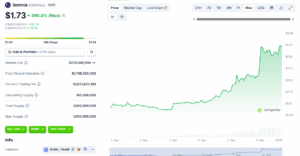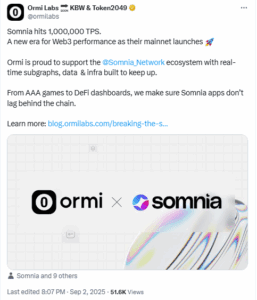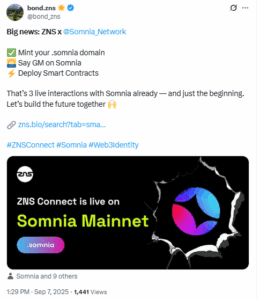Somnia’s SOMI price rose from about $0.39 at launch to nearly $1.84 within days, gaining more than 300%. The sharp price move placed Somnia among the most talked-about new launches this year. But the real test is whether this momentum can hold, or if SOMI will follow the pattern of other tokens that surged early, only to collapse once speculation cooled.

SOMI/USD All Time Price Chart. Source: CoinGecko
Somnia Raised $270M, Google Cloud Among 60 Validators
Somnia raised $270 million from investors such as a16z, SoftBank Vision Fund 2, Digital Currency Group, and SIG. It is also linked to technology firm Improbable and the Virtual Society Foundation, led by founder Paul Thomas.
At launch, the network introduced 60 validators, including Google Cloud. Validators are the computers that confirm transactions and secure the network. While participation from established firms gave Somnia immediate visibility, their long-term involvement will depend on whether the chain achieves real adoption.

Somnia promotes itself as a high-speed Layer-1 blockchain built for gaming, social platforms, and metaverses. Its architecture is different from many rivals. The network uses MultiStream consensus, which allows validators to process transactions in parallel before combining them. Contracts run through Accelerated EVM execution, where the system converts Ethereum code into machine-level instructions for faster performance. Storage happens on a custom database called IceDB, supported by compression techniques to reduce network traffic.
The project claims this setup can process over one million transactions per second with near-instant confirmation. The team recorded these figures during testnet trials, but they have not yet shown that the results hold under live market conditions.

Binance and KuCoin Listings Push Trading Volume Past $900M
The rally also coincided with SOMI’s immediate listings on Binance, KuCoin, Bybit, CoinEx, and WEEX, which provided liquidity and broad exposure. In the days following the listings, trading volumes exceeded $900 million in 24 hours, at times surpassing the project’s market capitalization of roughly $230 million.
Somnia added to the momentum by announcing integrations. The most visible was with ZNS Connect, which enabled .somnia domains for digital identity. Domain registrations grew from 45,000 in May to more than 68,000 by early September, and SOMI traded higher after the announcement. Other collaborations, including with LayerZero, Ankr, Sequence, and QuickSwap, signal an intention to expand into DeFi and gaming, though adoption from these partnerships is not yet measurable.

16% of SOMI Supply Circulating, Rest Locked Under Vesting
Users pay gas fees in SOMI, stake it to earn validator rewards, and will use it to govern protocol upgrades. Somnia has a fixed supply of 1 billion SOMI tokens. At launch, about 16% entered circulation. The rest is locked for teams, investors, and community allocations that will unlock gradually over three to four years.
Incentives played a key role in distribution. Binance distributed 30 million SOMI to BNB stakers, while another program allocated 5% of supply through quests with vesting schedules that limited immediate selling. Somnia also introduced a fee burn mechanism that removes half of all transaction fees from circulation. However, the impact of this mechanism depends on whether the network achieves sustained transaction volumes.
In early September, BitGo added support for SOMI, enabling institutional-grade custody. Custody services like this provide the infrastructure needed for larger investors to participate, though actual institutional demand has not yet been demonstrated.

Speculative Trading Echoes Past Token Launch Collapses
While Somnia’s launch was met with heavy trading, the pattern raises questions about sustainability. Derivatives data showed rising open interest and volumes in the days after launch, pointing to speculative activity. Reliance on speculation has often led to sharp corrections in other new tokens.
Recent history provides examples. World Liberty Financial’s WLFI token, tied to the Trump family, recorded billions in launch-day trading, but lost more than half its value within days. Argentina’s LIBRA token spiked to $5.20 in under an hour before dropping by 85%. Kanye West’s YZY token briefly reached a $3 billion valuation before falling by two-thirds. Each case shows how hype-driven launches can reverse quickly when trading volume cools or supply increases.
For SOMI, the concern is similar. With more than 80% of supply still locked, scheduled unlocks could expand circulation and weigh on SOMI price unless adoption grows in parallel. Somnia’s fee burn system may slow inflation, but its effectiveness will only become clear if the blockchain supports real transaction demand.
